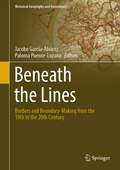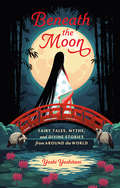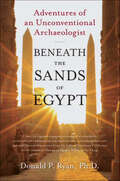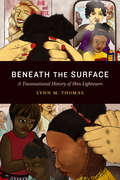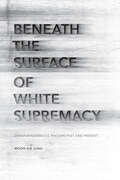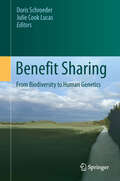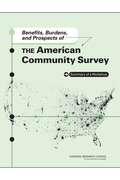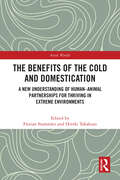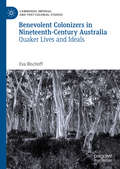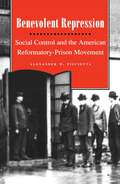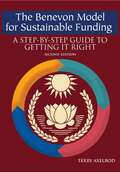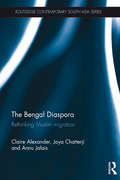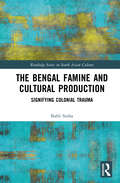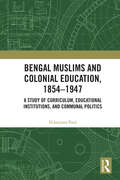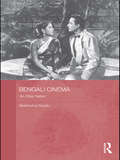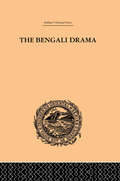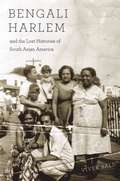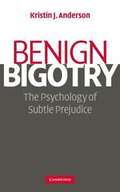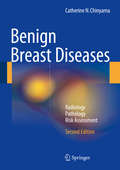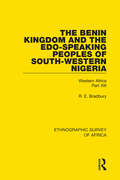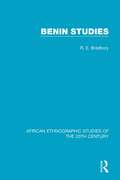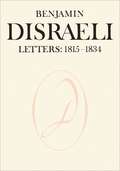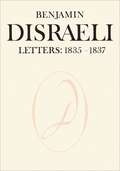- Table View
- List View
Beneath the Lines: Borders and Boundary-Making from the 18th to the 20th Century (Historical Geography and Geosciences)
by Jacobo García-Álvarez Paloma Puente-LozanoThis book brings together ten empirically rich and theoretically informed contributions that aim to clarify both geo-historical specificities and common transnational and global features of the cultures and practices of boundary making that shaped modern statehood. Written by scholars from Spain, France, Italy, Argentina, Brazil and Mexico, the essays included in this volume provide a comparative international perspective on the processes of border formation, as well as an integrative approach that seeks to strengthen the links between renewed geo-historical studies and more contemporary-oriented border studies. The book is addressed to a wide range of researchers, including geographers, historians, political scientists and specialists in geopolitics and the history of international relations.
Beneath the Moon: Fairy Tales, Myths, and Divine Stories from Around the World
by Yoshi YoshitaniPowerful and universal retellings of seventy-eight divine stories, legends, and myths from around the world, each accompanied by a gorgeous illustration from acclaimed artist Yoshi Yoshitani.Many of the lessons we learn are shared stories passed among cultures and generations. In this riveting collection of fables and folktales from cultures across the globe, characters from beloved fairytales, cultural fables, ancient mythologies, and inspirational deities are brought to life, including Sleeping Beauty (Italy), Rapunzel (Germany), Jack and the Beanstalk (England), Our Lady of Guadalupe (Mexico), Sun God Ra (Egypt), the Crane Wife (Japan), and dozens more. Lesser-known stories introduce characters such as the volcano goddess Pele from Hawaii; Mwindo, the wise and powerful king of the Nyanga people; and the strong and resilient Yennenga, mother of the Mossi people in Burkina Faso. The recurring themes of conquering evil, overcoming adversity, and finding love and companionship are woven throughout this collection.Yoshi Yoshitani's art style is fresh and unique, featuring diverse and multicultural characters. Each story will be featured opposite a correlating illustration, both lush and vibrant.
Beneath the Sands of Egypt: Adventures of an Unconventional Archaeologist
by Donald P. Ryan“Donald Ryan is a rare bird—a field archaeologist who can write with verve and immediacy. I heartily recommend his book to all Egyptology buffs.”—Barbara Mertz ( a.k.a. Elizabeth Peters), author of Temples, Tombs, and HieroglyphsA real-life “Indiana Jones,” Donald P. Ryan, Ph.D., offers a breathtaking personal account of his adventures in archaeology in Beneath the Sands of Egypt. Fans of The Lost City of Z will thrill to the exploits of this “unconventional archaeologist” as he retrieves the remains of Egypt’s past—including his breakthrough discovery in the Valley of the Kings of Egypt’s famous female pharaoh, Hatshepsut.
Beneath the Surface: A Transnational History of Skin Lighteners (Theory in Forms)
by Lynn M. ThomasFor more than a century, skin lighteners have been a ubiquitous feature of global popular culture—embraced by consumers even as they were fiercely opposed by medical professionals, consumer health advocates, and antiracist thinkers and activists. In Beneath the Surface, Lynn M. Thomas constructs a transnational history of skin lighteners in South Africa and beyond. Analyzing a wide range of archival, popular culture, and oral history sources, Thomas traces the changing meanings of skin color from precolonial times to the postcolonial present. From indigenous skin-brightening practices and the rapid spread of lighteners in South African consumer culture during the 1940s and 1950s to the growth of a billion-dollar global lightener industry, Thomas shows how the use of skin lighteners and experiences of skin color have been shaped by slavery, colonialism, and segregation as well as by consumer capitalism, visual media, notions of beauty, and protest politics. In teasing out lighteners&’ layered history, Thomas theorizes skin as a site for antiracist struggle and lighteners as a technology of visibility that both challenges and entrenches racial and gender hierarchies.
Beneath the Surface of White Supremacy: Denaturalizing U.S. Racisms Past and Present
by Moon-Kie JungRacism has never been simple. It wasn't more obvious in the past, and it isn't less potent now. From the birth of the United States to the contemporary police shooting death of an unarmed Black youth, Beneath the Surface of White Supremacy investigates ingrained practices of racism, as well as unquestioned assumptions in the study of racism, to upend and deepen our understanding. In Moon-Kie Jung's unsettling book, Dred Scott v. Sandford, the notorious 1857 Supreme Court case, casts a shadow over current immigration debates and the "war on terror. " The story of a 1924 massacre of Filipino sugar workers in Hawai'i pairs with statistical relentlessness of black economic suffering to shed light on hidden dimensions of mass ignorance and indifference. The histories of Asians, blacks, the Indigenous, and Latina/os relate in knotty ways. State violence and colonialism come to the fore in taking measure of the United States, past and present, while the undue importance of assimilation and colorblindness recedes. Ultimately, Jung challenges the dominant racial common sense and develops new concepts and theory for radically rethinking and resisting racisms.
Benefit Sharing: From Biodiversity to Human Genetics
by Doris Schroeder Julie Cook LucasBiomedical research is increasingly carried out in low- and middle-income countries. International consensus has largely been achieved around the importance of valid consent and protecting research participants from harm. But what are the responsibilities of researchers and funders to share the benefits of their research with research participants and their communities? After setting out the legal, ethical and conceptual frameworks for benefit sharing, this collection analyses seven historical cases to identify the ethical and policy challenges that arise in relation to benefit sharing. A series of recommendations address possible ways forward to achieve justice for research participants in low- and middle-income countries.
Benefits, Burdens, and Prospects of the American Community Survey:
by Daniel L. CorkIn June 2012, the Committee on National Statistics (sponsored by the U. S. Census Bureau) convened a Workshop on the Benefits (and Burdens) of the American Community Survey (ACS)---the detailed demographic and economic survey that began full-scale data collection in 2005 and that replaced the traditional "long form" in the 2010 census. ACS data are used by numerous federal agencies to administer programs, yet the ACS only moved from abstraction to reality for most users in 2010, when the first ACS estimates for small areas (based on 5 years of collected data) were made available. Hence, the workshop marked the opportunity to develop a picture of the breadth of the nonfederal user base of the ACS---among them, the media, policy research and evaluation groups (that distill ACS results for the media and broader public), state and local agencies, businesses and economic development organizations, and local and regional planning authorities---and to gather information on users' experiences with the first full releases of ACS products. In addition to covering innovative uses of the information now available on a continuous basis in the ACS, the workshop gave expression to the challenges and burdens associated with the survey: the time burden places on respondents, the challenges of explaining and interpreting estimates with increased levels of variability, and the privacy and confidentiality implications of some of the ACS content. Benefits, Burdens, and Prospects of the American Community Survey: Summary of a Workshop provides a factual summary of the workshop proceedings and hints at the contours of the ACS user constituency, providing important input to the ongoing review and refinement of the ACS program.
The Benefits of the Cold and Domestication: A New Understanding of Human–Animal Partnerships for Thriving in Extreme Environments (Arctic Worlds)
by Florian Stammler Hiroki TakakuraThis book explores cooperation between humans and animals in extreme environments and contends that understanding domestication is crucial to explaining how life is possible in such conditions.The chapters draw on work from anthropology, genetics, law, and geography, with a range of ethnographic case studies from cold environments. The contributors offer new evidence for rethinking the dichotomy of trust vs domination previously used to characterize human-animal relations. They show how humans and animals partner for survival, and how a cold environment does not merely threaten existence but rather creates opportunities. Domestication is presented as a continuous, mutually beneficial human-animal relationship of becoming familiar with each other and the surrounding environment, which can lead to a symbiotic partnership of multiple agents for adapting to changes including a warming climate.This volume will be relevant to scholars from anthropology, geography, and related disciplines interested in human-animal relations, ecology, and the environment, particularly in the North.
Benevolent Colonizers in Nineteenth-Century Australia: Quaker Lives and Ideals (Cambridge Imperial and Post-Colonial Studies Series)
by Eva BischoffThis book reconstructs the history of a group of British Quaker families and their involvement in the process of settler colonialism in early nineteenth-century Australia. Their everyday actions contributed to the multiplicity of practices that displaced and annihilated Aboriginal communities. Simultaneously, early nineteenth-century Friends were members of a translocal, transatlantic community characterized by pacifism and an involvement in transnational humanitarian efforts, such as the abolitionist and the prison reform movements as well as the Aborigines Protection Society. Considering these ideals, how did Quakers negotiate the violence of the frontier? To answer this question, the book looks at Tasmanian and South Australian Quakers’ lives and experiences, their journeys and their writings. Building on recent scholarship on the entanglement between the local and the global, each chapter adopts a different historical perspective in terms of breadth and focused time period. The study combines these different takes to capture the complexities of this topic and era.
Benevolent Repression: Social Control and the American Reformatory-Prison Movement
by Alexander W. PisciottaThe opening, in 1876, of the Elmira Reformatory marked the birth of the American adult reformatory movement and the introduction of a new approach to crime and the treatment of criminals. Hailed as a reform panacea and the humane solution to America's ongoing crisis of crime and social disorder, Elmira sparked an ideological revolution. Repression and punishment were supposedly out. Academic and vocational education, military drill, indeterminate sentencing and parole-"benevolent reform"-were now considered instrumental to instilling in prisoners a respect for God, law, and capitalism. Not so, says Al Pisciotta, in this highly original, startling, and revealing work. Drawing upon previously unexamined sources from over a half-dozen states and a decade of research, Pisciotta explodes the myth that Elmira and other institutions of "the new penology" represented a significant advance in the treatment of criminals and youthful offenders. The much-touted programs failed to achieve their goals; instead, prisoners, under Superintendent Zebulon Brockway, considered the Father of American Corrections, were whipped with rubber hoses and two-foot leather straps, restricted to bread and water in dark dungeons during months of solitary confinement, and brutally subjected to a wide range of other draconian psychological and physical abuses intended to pound them into submission. Escapes, riots, violence, drugs, suicide, arson, and rape were the order of the day in these prisons, hardly conducive to the transformation of "dangerous criminal classes into Christian gentleman," as was claimed. Reflecting the racism and sexism in the social order in general, the new penology also legitimized the repression of the lower classes. Highlighting the disparity between promise and practice in America's prisons, Pisciotta draws on seven inmate case histories to illustrate convincingly that the "March of Progress" was nothing more than a reversion to the ways of old. In short, the adult reformatory movement promised benevolent reform but delivered benevolent repression-a pattern that continues to this day. A vital contribution to the history of crime, corrections, and criminal justice, this book will also have a major impact on our thinking about contemporary corrections and issues surrounding crime, punishment, and social control.
The Benevon Model For Sustainable Funding: A Step-by-step Guide To Getting It Right, Second Edition
by Terry AxelrodDesigned for small to mid-sized nonprofits who want to get started implementing the Benevon Model for Sustainable Funding on their own and who want to do it right. With significant edits to nearly every page, this second edition gives you our up-to-date metrics, easy-to-follow scripts, templates, checklists, rules, and formulas. This book synthesizes Benevon s state-of-the-art work with more than 5,000 nonprofit teams of board members, volunteers, and staff and makes them available for first-time implementers. While this will not take the place of working with Benevon directly, if you are willing to take on and carefully follow the tried and tested directions here, you will avoid the biggest mistakes of self-implementation, and you will be rewarded with a breakthrough in sustainable funding for your favorite nonprofit organization.
The Bengal Diaspora: Rethinking Muslim migration (Routledge Contemporary South Asia Series)
by Claire Alexander Joya Chatterji Annu JalaisIndia’s partition in 1947 and the creation of Bangladesh in 1971 saw the displacement and resettling of millions of Muslims and Hindus, resulting in profound transformations across the region. A third of the region’s population sought shelter across new borders, almost all of them resettling in the Bengal delta itself. A similar number were internally displaced, while others moved to the Middle East, North America and Europe. Using a creative interdisciplinary approach combining historical, sociological and anthropological approaches to migration and diaspora this book explores the experiences of Bengali Muslim migrants through this period of upheaval and transformation. It draws on over 200 interviews conducted in Britain, India, and Bangladesh, tracing migration and settlement within, and from, the Bengal delta region in the period after 1947. Focussing on migration and diaspora ‘from below’, it teases out fascinating ‘hidden’ migrant stories, including those of women, refugees, and displaced people. It reveals surprising similarities, and important differences, in the experience of Muslim migrants in widely different contexts and places, whether in the towns and hamlets of Bengal delta, or in the cities of Britain. Counter-posing accounts of the structures that frame migration with the textures of how migrants shape their own movement, it examines what it means to make new homes in a context of diaspora. The book is also unique in its focus on the experiences of those who stayed behind, and in its analysis of ruptures in the migration process. Importantly, the book seeks to challenge crude attitudes to ‘Muslim’ migrants, which assume their cultural and religious homogeneity, and to humanize contemporary discourses around global migration. This ground-breaking new research offers an essential contribution to the field of South Asian Studies, Diaspora Studies, and Society and Culture Studies.
The Bengal Famine and Cultural Production: Signifying Colonial Trauma (Routledge Series on South Asian Culture)
by Babli SinhaThe Bengal Famine and Cultural Production: Signifying Colonial Trauma analyses the various modes of representation used by Anglophone authors and artists in response to the Bengal Famine of 1943. Official imperial narratives blamed the famine on natural disaster, war, exploitation by merchants, and incompetent local officials rather than members of the imperial government and have remained dominant in the global public imaginary until recent years. The authors and artists referenced in this study appealed to elite Bengali, South Asian, and international audiences to resist imperial narratives that minimized or erased suffering and instead encouraged relief efforts, promoted nationalist movements, maintained collective memory, innovated ethical forms of representation, and prompted systemic change. They were part of an established tradition of English in the subcontinent as the language of empire and cosmopolitanism but are not accessible, widely taught, or well-known. The direct encounter with suffering was and remains insufficient for prompting systemic change or even engagement, and yet, the recognition of trauma is crucial for personal and collective well-being. The cultural production of famine writers and artists sought to integrate the suffering and agency of the destitute into narratives of Bengali and South Asian identity and of the Second World War. It is crucial to the Humanities to recognize this body of work as a cultural counter-discourse to the biopower of empire and to engage these texts as relevant to theories of trauma. The book will be of interest to researchers in the field of South Asian history, the history of the Bengal famine, South Asian Anglophone literature, twentieth century art history, and trauma theory.
Bengal Muslims and Colonial Education, 1854–1947: A Study of Curriculum, Educational Institutions, and Communal Politics
by Nilanjana PaulThis book examines the impact of British education policies on the Muslims of Colonial Bengal. It evaluates the student composition and curriculum of various educational institutions for Muslims in Calcutta and Dacca to show how they produced the educated Muslim middle class. The author studies the role of Muslim leaders such as Abdul Latif and Fazlul Huq in the spread of education among Muslims and looks at how segregation in education supported by the British fueled Muslim anxiety and separatism. The book analyzes the conflict of interest between Hindus and Muslims over education and employment which strengthened growing Muslim solidarity and anti- Hindu feeling, eventually leading to the demand for a separate nation. It also discusses the experiences of Muslim women at Sakhawat Memorial School, Lady Brabourne College, Eden College, Calcutta, and Dacca Universities at a time when several Brahmo and Hindu schools did not admit them. An important contribution to the study of colonial education in India, the book highlights the role of discriminatory colonial education policies and pedagogy in amplifying religious separatism. It will be useful for scholars and researchers of modern Indian history, religion, education, Partition studies, minority studies, imperialism, colonialism, and South Asian history.
Bengali Cinema: 'An Other Nation' (Routledge Contemporary South Asia Series)
by Sharmistha GooptuCovering the years spanning cinema’s emergence as a popular form in Bengal in the first half of the twentieth century, this book examines the main genres and trends produced by this cinema, and leads up to Bengali cinema’s last phase of transition in the 1980s. Arguing that Bengali cinema has been a key economic and social institution, the author highlights that the Bengali filmic imaginary existed over and above the imaginary of the Indian nation. This book argues that a definitive history of Bengali cinema presents an alternative understanding to the currently influential notion of the Hindi film as the ‘Indian’ or ‘national’ cinema. It suggests that the Bengali cinema presents a history which brings to the fore the deeply contested terrain of ‘national’ cinema, and shows the creation of the ‘alternative imaginary’ of the Bengali film. The author indicates that the case of the Bengali cinema demonstrates the emergence of a public domain that set up a definitive discourse of difference with respect to the ‘all-India’ Hindi film, popularly classified as Bollywood cinema, and which pre-empted its subsumption within the more pervasive culture of the Bombay Hindi cinema. As the first comprehensive historical work on Bengali cinema, this book makes a significant contribution to both Film and Cultural Studies and South Asian Studies in general.
The Bengali Drama: Its Origin and Development
by P. Guha-ThakurtaThis is Volume V out of eleven that form a collection on India, its History, Economy and Society. First published in 1930, this book looks at the origin and development of Bengali Drama and contains matter for historians, as well as direct criticism of what the author considers to be genuinely dramatic in the literature of Bengal, past or present.
Bengali Harlem and the Lost Histories of South Asian America
by Vivek BaldIn the final years of the nineteenth century, small groups of Muslim peddlers arrived at Ellis Island every summer, bags heavy with embroidered silks from their home villages in Bengal. The American demand for Oriental goods took these migrants on a curious path, from New Jersey’s beach boardwalks into the heart of the segregated South. <P><P>Two decades later, hundreds of Indian Muslim seamen began jumping ship in New York and Baltimore, escaping the engine rooms of British steamers to find less brutal work onshore. As factory owners sought their labor and anti-Asian immigration laws closed in around them, these men built clandestine networks that stretched from the northeastern waterfront across the industrial Midwest. The stories of these early working-class migrants vividly contrast with our typical understanding of immigration. <P><P>Vivek Bald’s meticulous reconstruction reveals a lost history of South Asian sojourning and life-making in the United States. At a time when Asian immigrants were vilified and criminalized, Bengali Muslims quietly became part of some of America’s most iconic neighborhoods of color, from Tremé in New Orleans to Detroit’s Black Bottom, from West Baltimore to Harlem. Many started families with Creole, Puerto Rican, and African American women. As steel and auto workers in the Midwest, as traders in the South, and as halal hot dog vendors on 125th Street, these immigrants created lives as remarkable as they are unknown. Their stories of ingenuity and intermixture challenge assumptions about assimilation and reveal cross-racial affinities beneath the surface of early twentieth-century America.
Benign Bigotry: The Psychology of Subtle Prejudice
by Kristin J. AndersonWhile overt prejudice is now much less prevalent than in decades past, subtle prejudice - prejudice that is inconspicuous, indirect, and often unconscious - continues to pervade our society. Laws do not protect against subtle prejudice and, because of its covert nature, it is difficult to observe and frequently goes undetected by both perpetrator and victim. Benign Bigotry uses a fresh, original format to examine subtle prejudice by addressing six commonly held cultural myths based on assumptions that appear harmless but actually foster discrimination: 'those people all look alike'; 'they must be guilty of something'; 'feminists are man-haters'; 'gays flaunt their sexuality'; 'I'm not a racist, I'm color-blind' and 'affirmative action is reverse racism'. Kristin J. Anderson skillfully relates each of these myths to real world events, emphasizes how errors in individual thinking can affect society at large, and suggests strategies for reducing prejudice in daily life.
Benign Breast Diseases: Radiology - Pathology - Risk Assessment
by Catherine N. ChinyamaThe second edition of this book has been extensively revised and updated. There has been a lot of scientific advances in the radiology, pathology and risk assessment of benign breast lesions since the publication of the first edition. The first edition concentrated on screen-detected lesions, which has been rectified. New symptomatic and screen-detected lesions are discussed in the second edition and include: mastitis and breast abscess, idiopathic granulomatous mastitis, diabetic mastopathy, phyllodes tumour, gynaecomastia and pseudoangiomatous stromal hyperplasia. The chapters on columnar cell lesions and mucocele-like lesions have been extensively updated. Where applicable, genetic analysis of the benign lesions which in breast cancer is becoming part of personalised medicine has been included. The book includes detailed analysis of the main models such as the Gail Model used to assess the subsequent risk of breast cancer in individuals. The current trend in the management of all cancers is preventative. Screening mammography detects early curable cancers as well as indeterminate lesions. These indeterminate mammographic lesions are invariably pathologically benign. The author collated important benign lesions and based on peer-reviewed publications documented the relative risk of subsequent cancer to allow the patient and the clinician to institute preventative measures where possible. This book therefore will be an essential part of multidisciplinary management of patients with symptomatic and screen-detected benign breast lesions.
Benin: Poverty Reduction Strategy Paper--Annual Progress Report
by International Monetary FundA report from the International Monetary Fund.
Benin: Second Poverty Reduction Strategy Paper--Joint Staff Advisory Note
by International Monetary FundA report from the International Monetary Fund.
The Benin Kingdom and the Edo-Speaking Peoples of South-Western Nigeria: Western Africa Part XIII
by R. E. BradburyRoutledge is proud to be re-issuing this landmark series in association with the International African Institute. The series, published between 1950 and 1977, brings together a wealth of previously un-co-ordinated material on the ethnic groupings and social conditions of African peoples. Concise, critical and (for its time) accurate, the Ethnographic Survey contains sections as follows: Physical Environment Linguistic Data Demography History & Traditions of Origin Nomenclature Grouping Cultural Features: Religion, Witchcraft, Birth, Initiation, Burial Social & Political Organization: Kinship, Marriage, Inheritance, Slavery, Land Tenure, Warfare & Justice Economy & Trade Domestic Architecture Each of the 50 volumes will be available to buy individually, and these are organized into regional sub-groups: East Central Africa, North-Eastern Africa, Southern Africa, West Central Africa, Western Africa, and Central Africa Belgian Congo. The volumes are supplemented with maps, available to view on routledge.com or available as a pdf from the publishers.
Benin Studies
by R. E. BradburyThis collection of R. E. Bradbury's papers, originally published in 1973 includes edited sections of his (then hitherto) unpublished thesis on the Benin village in Western Nigeria. The book is arranged in 3 parts: historical and political studies of the kingdom of Benin; Benin village organization and religion and art. An introduction by Peter Morton-Williams traces bradbury's development as an interpreter of the culture, society and art of Benin, beginning with his first studies in the filed and culminating in the important anthropological and historical essays.
Benjamin Disraeli Letters: 1815-1834, Volume I
by Benjamin Disraeli John Gunn John Matthews Donald Schurman Melvin WiebeThe private letters of a statesman are always inviting material for historians and when he has claim to literary fame as well the correspondence assumes a double significance. Benjamin Disraeli (1804-1881) belonged to an age that gave pride of place to the written word as an instrument of both business and pleasure. This volume includes 363 letters (many previously unpublished) from his school boy days to his establishment in the Tory camp under the patronage of Lord Lyndhurst. Most prominent are Disraeli's letters to his sister, Sarah, with whom he corresponded frequently over several decades. To her he confided his hopes, interspersed with his observations and descriptions of social, literary and political events. The letters to Sarah supply a skeleton around which Disraeli's young manhood can be reconstructed and shed valuable light on the remaining documents in the volume. The correspondence also includes accounts of his tour of the Low Countries and the Rhine in 1824, his adventurous trip to Spain, Greece, the Near East and Egypt in 1830, his tense negotiations with publishers and his campaign to shine as a member of aristocratic society and win political patronage. The letters demonstrate the fine eye for detail and the capacity for self-dramatization and literary conceits which mark his novels. With their annotations they also provide a remarkably detailed account of life in the upper reaches of English society as viewed from below, and of Disraeli's ambitions to enter that life.
Benjamin Disraeli Letters: 1835-1837, Volume II
by Benjamin Disraeli John Gunn John Matthews Donald Schurman Melvin WiebeThe 334 letters in this volume cover the period from Disraeli's establishment in the Tory camp under the patronage of Lord Lyndhurst to his election to parliament in 1837. The most important issue to which they speak is the course of Disraeli's political ambitions. In 1835 the road to parliament was not yet clear, for he continued to be haunted by troubles from his past. He was beset by charges of opportunism in his Taunton campaign of 1835, and the longest letters here are those to Edwards Beadon written in justification of past conduct; Disraeli had still to learn the truth of his later dictum, 'never explain.' Also, debts contracted many years before continued to plague him, as they would in years to come. He was tempted by a variety of money-making schemes and the later correspondence makes clear just how close he came to permanent ruin at the hands of his creditors in the spring of 1837. Had the fate of debtors' prison materialized it is doubtful that he would ever have been eligible, in law or in reputation, for a parliamentary career. Disraeli's eventual election for Maidstone in the summer of 1837 marked the emergence of his formal public role. Because he set out early and was a long time in attaining his goals, one is tempted to laud his patience. But the record here suggests that it was instead a matter of energy and endurance. This volume of the Letters brings Disraeli to the threshold of the Victorian era and the beginning of his career as a politician. In late 1837 he failed in his maiden speech, but all major successes lay ahead.
